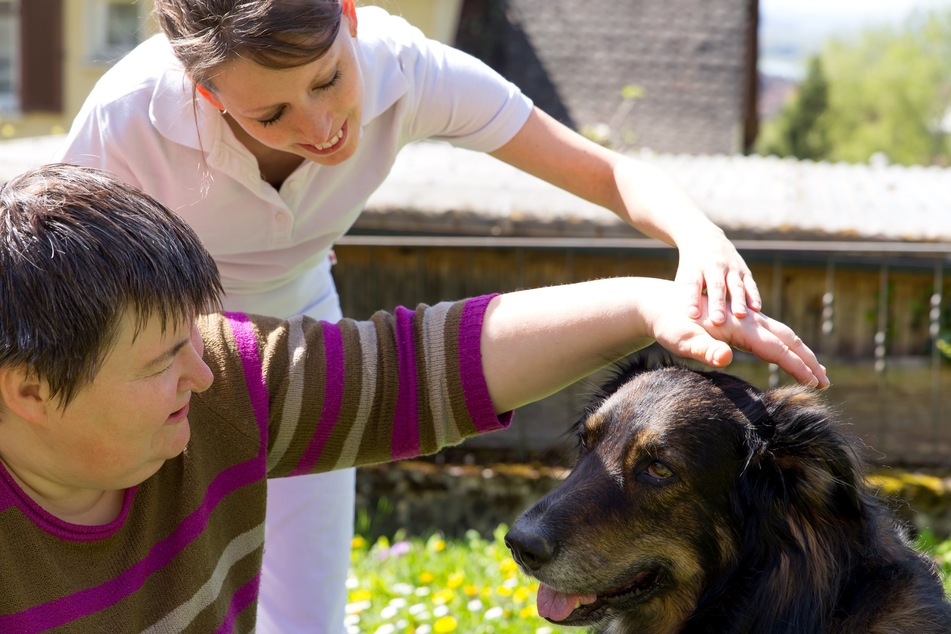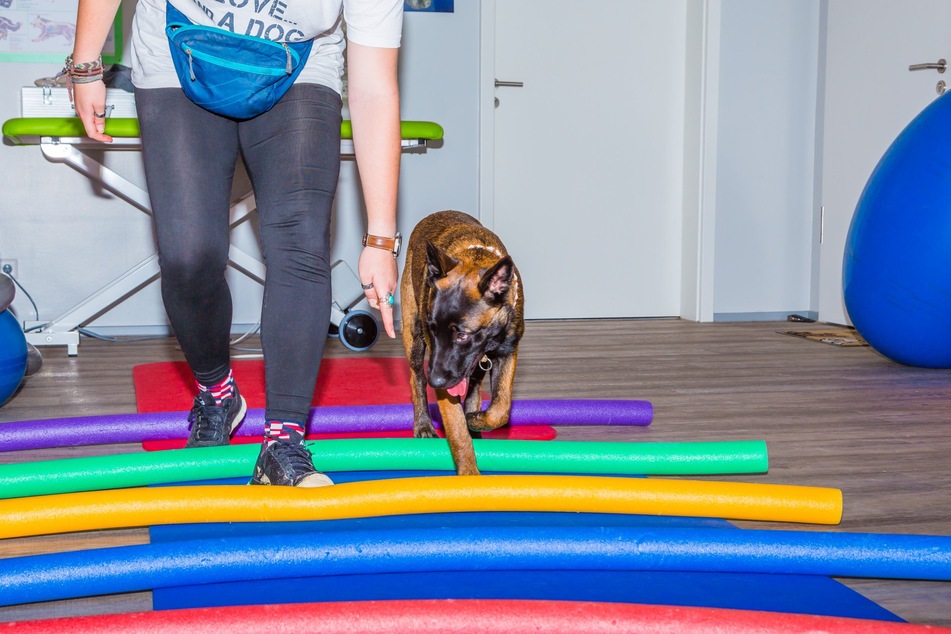Many people react positively to their environment simply in the presence of a dog. Not for nothing, these four-legged companions are among the most popular pets in the United States. However, their empathic abilities are increasingly finding application in therapeutic measures. As trained therapy dogs, these animals indeed have a beneficial impact on various treatments.
- Therapy Dog as a Component of Animal-Assisted Therapy
- Which Dog Breeds are Suitable as Therapy Dogs?
- What Makes a Therapy Dog?
- Where is a Therapy Dog Used?
- Deployment Locations for Therapy Dogs
- What Achievements Can Be Attained Through a Therapy Dog?
- What Does the Work of a Therapy Dog Look Like?
- Therapy Dog: What Regulations Must Be Considered?
Therapy Dog as a Component of Animal-Assisted Therapy
Several studies have already proven it: dogs make us happy. They can not only contribute to promoting our social interactions but also have a stress-relieving and even blood pressure-lowering effect on us.
These positive influences on us humans are increasingly utilized in so-called animal-assisted therapies. These are alternative medical treatment methods that find application in the healing or improvement of symptoms of certain diseases and disabilities.
In addition to dogs, therapy animals include horses, llamas, sheep, cats, and dolphins.
This iHugDogs Guide has compiled some interesting and helpful facts about the therapy dog and its influence on the recovery process in humans.
Key Information for Quick Readers:
- Some dog breeds are particularly well-suited as therapy dogs, but it primarily depends on the abilities of the individual animal, not primarily on the breed.
- Therapy dogs can positively influence the healing process of certain mental and physical illnesses or disabilities.
- Therapy animals always work together as a team with their medically, therapeutically, pedagogically, or otherwise socially trained handlers.
- Depending on the medical condition and therapy goal, the therapy dog’s work can be in an active or reactive form.
- Approval as a therapy dog only occurs after a state-administered examination.
- Attention must always be paid to the health of the animal.
Which Dog Breeds are Suitable as Therapy Dogs?
In general, the question of the breed plays a subordinate role in the selection of a therapy dog. Regardless of size, gender, or breed, what matters most are the necessary character traits.
The following dog breeds are particularly popular in animal-assisted therapies:
- Australian Shepherd
- Beagle
- Bernese Mountain Dog
- Saint Bernard
- Border Collie
- German Shepherd
- Golden Retriever
- Labrador Retriever
- Maltese
- Pug
- Newfoundland
- Poodle
- Sheltie
What Makes a Therapy Dog?

Although the mentioned dog breeds often make excellent therapy dogs, as mentioned, it primarily depends on individual traits. Because:
During their work as therapy animals, dogs encounter many different people with various characters, illnesses, disabilities, or other restrictions or peculiarities.
In addition, unfamiliar environments and smells, as well as sometimes medical devices, are added, with which the animal usually does not come into contact.
Therefore, a therapy dog is only suitable for the activity if it meets certain requirements. These include, among others:
- Basic obedience
- Good social behavior towards both humans and other counterparts
- The ability to remain calm in difficult or unforeseen situations
- Low aggression potential
- Pronounced amiability
- An open nature
- Good leash control
- A friendly approach to strangers.
Dogs with excessively pronounced territorial behavior, a low threshold for stimuli, or a strong protective instinct are rather unsuitable for employment as therapy animals.
Where is a Therapy Dog Used?

Therapy dogs can assist in many different medical and educational institutions in the healing process related to:
- Psychotherapy
- Occupational therapy
- Speech therapy
- Learning therapy
- Nursing
- Special education or
- Physiotherapy
Through their targeted participation in therapeutic measures, sometimes significant improvements in the well-being and behavior of people can be observed. This applies to physical and neurological as well as mental and intellectual illnesses or disabilities.
Therefore, therapy dogs can help, among other things, in the treatment of depression, perceptual disorders, language problems, learning difficulties, anxiety, as well as other developmental disorders and limitations.
Deployment Locations for Therapy Dogs
The animals support not only seniors and children but also other age groups.
Thus, they find their use not only in the home environment but especially in:
- Hospitals
- Day clinics
- Facilities for people with disabilities
- Nursing homes
- Kindergartens
- Schools and
- Special education practices.
Not every dog is suitable for every area. It should be individually assessed in which areas of animal-assisted therapy the four-legged companion can really have a beneficial effect.
What Achievements Can Be Attained Through a Therapy Dog?

Due to their nature and empathic abilities, dogs can radiate a sense of security, warmth, and comfort through their mere presence alone. They keenly perceive mood swings and yet react impartially, non-judgmentally, and without accusations.
Therapy dogs often succeed in building a connection with their clients faster and more easily than the respective human therapists can.
Whether emotional expressions or physical progress, these four-legged companions excel at bringing out the best in people, accepting them just as they are—regardless of how they look, speak, or move.
Here are a few examples of treatment successes that can be achieved through the influence of a therapy dog:
- Improvement of communication skills
- Strengthening of self-esteem
- Promotion of responsibility
- Enhancement of concentration and performance
- Reduction of stress
- Alleviation of anxiety
- Lowering of blood pressure
- Improvement of motor skills
- Relaxation of muscles
- Optimization of language and expressive abilities
- Promotion of social integration.
What Does the Work of a Therapy Dog Look Like?
A therapy dog, within its capabilities, can contribute to achieving both subtle and tangible progress in treatment. Its activity depends on the medical condition and the therapy form, taking place in either active or reactive form.
Therapy Dog: Active Form
In the active variant, individuals undergoing treatment are encouraged by the dog to be actively engaged and perform a specific activity. The four-legged companion can be fed, petted, brushed, taken for a walk, or engaged in play. This not only strengthens self-esteem and responsibility but can also help in overcoming depressive and lethargic phases.
Therapy Dog: Reactive Form
In contrast to the active form, in the reactive variant, the therapy dog assumes a more passive position. Due to its empathic abilities, it can react situationally to the feelings and emotions of its counterpart. Especially with bedridden or extremely weakened individuals, it is often sufficient for the dog to lie beside them, motivating small touches.
However, it should never be forgotten that dogs are not miracle healers and should not be overburdened.
By the way!
Therapy dogs are not assistance dogs. The main difference is that assistance dogs are specifically trained for individual people and their needs. They live as family members with them, supporting them in their daily lives. Therapy dogs, on the other hand, live with their handler and form a team with them to help other people therapeutically for a certain period. Outside their working hours, they are ordinary pets.
Therapy Dog: What Regulations Must Be Considered?

Training of the Dog Owner:
Ideally, owners of therapy dogs offering animal-assisted therapy are trained in a medical, pedagogical, therapeutic, or similarly socially oriented profession.
Completion of a Training Course:
For the dog and human to function as a perfect team to optimally help their clientele, those who decide to engage their four-legged companion as a therapy animal should undergo suitable training together. This training is offered by various institutes and associations. Ideally, training for therapy animals begins in their puppyhood.
State Examination:
Participation in a training course alone is not sufficient to allow a dog to be recognized as a therapy dog in Germany. A state examination must be completed beforehand. This consists of a temperament test for the animal and a written and oral test for the dog owner.
Working Hours of the Therapy Dog:
Despite the influence a therapy dog can have on people during treatment, attention must still be paid to the needs and well-being of the four-legged companion. Therefore, it is recommended not to let the therapy dog work for more than 45 minutes a day. When using multiple animals during a therapeutic session, the time can be extended to a maximum of two hours. However, it is necessary to provide the animals with a retreat option. The work as a therapy dog should not exceed three times a week.
Health of the Dog:
In addition to the regulations mentioned, the health of the animal should never be overlooked. Only a completely healthy and content dog can contribute to therapeutic success. Therefore, the dog should be pain-free, have all necessary vaccinations, and undergo regular deworming, among other health considerations. Regular check-ups and examinations of a therapy dog by a veterinarian are mandatory.
Conclusion
Dogs have empathic abilities, allowing them to perceive the feelings and mood swings of us humans and respond accordingly. This unique trait is increasingly being utilized by individuals working in social services through animal-assisted therapies. To do so, the animals and their handlers must meet specific training and other requirements.


